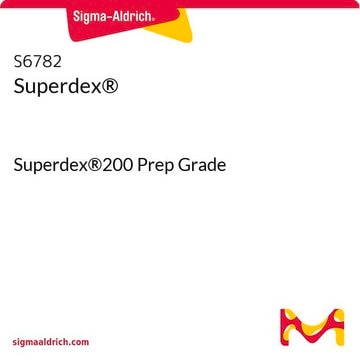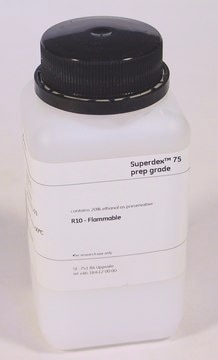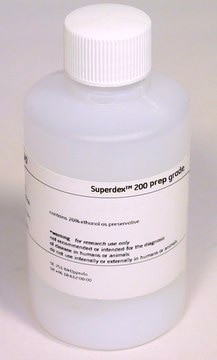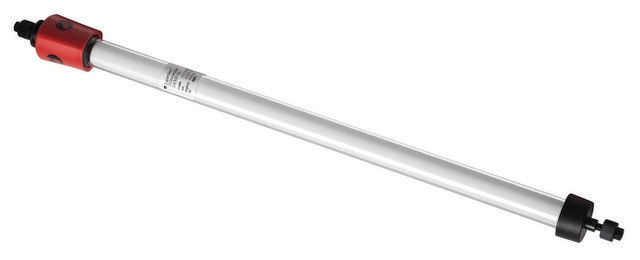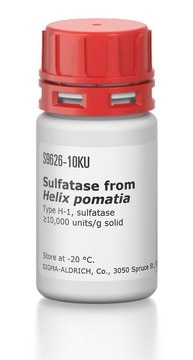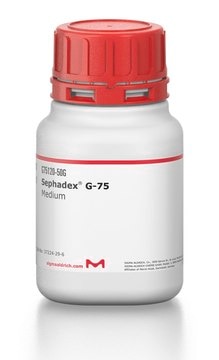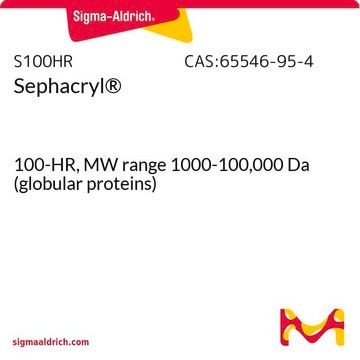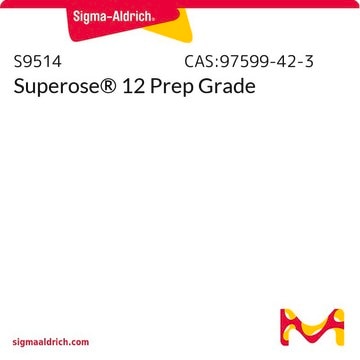S6657
Superdex®
Superdex®75 Prep Grade
Synonym(s):
Superdex Resin
Sign Into View Organizational & Contract Pricing
All Photos(1)
About This Item
Recommended Products
Quality Level
form
suspension (20% aqueous ethanol)
technique(s)
protein array: suitable
matrix
cross-linked agarose
particle size
24-44 μm
pore size
3-70 kDa MW range (proteins)
500-30,000 Da MW range (dextrans)
operating pH range
1-14(short term)
3-12(long term)
storage temp.
2-8°C
Looking for similar products? Visit Product Comparison Guide
General description
Combines the high selectivity of a Sephadex matrix with the chemical and physical stability of crosslinked agarose.
Application
Superdex® is used for protein chromatography, gel filtration chromatography, gel filtration media, resins and separation media. Superdex® has been used for the purification and characterization of a novel laccase from the edible mushroom Hericium coralloides. Superdex® has also been used for the purification and mechanism exploration of a potential human hepatocellular carcinoma inhibitor from Bauhinia purpurea L. seeds.
Optimized for high resolution preparative separations by size exclusion chromatography. Recommended fractionation ranges are listed for globular proteins and dextrans.
Legal Information
Superdex is a registered trademark of Cytiva
signalword
Warning
hcodes
Hazard Classifications
Flam. Liq. 3
wgk_germany
WGK 3
flash_point_f
104.0 °F
flash_point_c
40 °C
Certificates of Analysis (COA)
Search for Certificates of Analysis (COA) by entering the products Lot/Batch Number. Lot and Batch Numbers can be found on a product’s label following the words ‘Lot’ or ‘Batch’.
Already Own This Product?
Find documentation for the products that you have recently purchased in the Document Library.
Customers Also Viewed
M Maiorino et al.
FASEB journal : official publication of the Federation of American Societies for Experimental Biology, 12(13), 1359-1370 (1998-10-08)
Selenium deficiency is known to be associated with male infertility, and the selenoprotein PHGPx has been shown to increase in rat testis after puberty and to depend on gonadotropin stimulation in hypophysectomized rats [Roveri et al. (1992) J. Biol. Chem.
M Belew et al.
Journal of chromatography. A, 679(1), 67-83 (1994-09-09)
Recombinant human granulocyte-macrophage colony-stimulating factor (rhGM-CSF), produced as inclusion bodies in genetically transformed Escherichia coli cells was purified to homogeneity by a three-step chromatographic procedure involving hydrophobic interaction, ion exchange and gel filtration. Each purification step is reproducible and well
Toshiro Matsunaga et al.
Plant physiology, 134(1), 339-351 (2003-12-13)
Borate ester cross-linking of the cell wall pectic polysaccharide rhamnogalacturonan II (RG-II) is required for the growth and development of angiosperms and gymnosperms. Here, we report that the amounts of borate cross-linked RG-II present in the sporophyte primary walls of
Cornelia Steinhauer et al.
Proteomics, 6(15), 4227-4234 (2006-07-11)
Antibody-based microarray is a novel technology with great promise in biomedicine that will provide unique means to perform global proteome analysis. In the process of designing the high-density antibody microarrays required, several critical key issues have been identified that remain
Xindu Geng et al.
Journal of biotechnology, 113(1-3), 137-149 (2004-09-24)
A new technology for renaturation with simultaneous purification of the recombinant human interferon-gamma (rhIFN-gamma) in downstream of biotechnology is presented. The strategies to develop the new technology in industry scale were suggested. Based on chemical equilibrium and molecular interactions, the
Our team of scientists has experience in all areas of research including Life Science, Material Science, Chemical Synthesis, Chromatography, Analytical and many others.
Contact Technical Service
